
Watch our 32-minute abridged version of our live guided tour.
Podcast Episode: Listen to tour guides Lori and Katherine discuss Central Park on an episode of our NYC Travel Tips podcast.
This podcast offers bite-sized audio clips with tips on how to plan your trip to NYC. You can get our podcasts on Apple, Google, or wherever you get your podcasts.
WHAT TO DO IN CENTRAL PARK
This tour covers about 5 miles (8 km), so you may want to split your visit in half.
We have designed this tour to give you the options and directions you need to stop at 79th Street or continue north.
Lastly, check out our GPS-enabled audio tours of Central Park.
Click the map to enlarge or to download it to a smartphone.
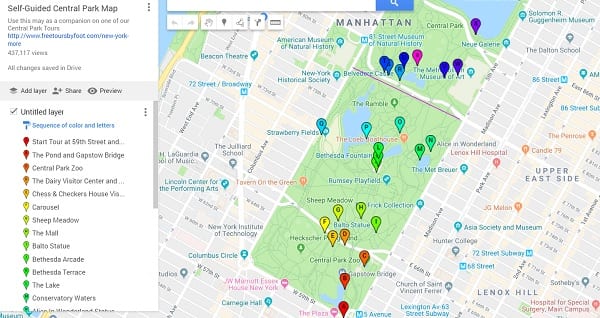
You can also download a PDF version of our Central Park Self Guided Tour.
(A) Start the tour
Enter the park at the southeast entrance (59th and 5th Avenue) across from The Plaza hotel. Walk up East Drive and you will see on your left the first stop on the tour.
(B) The Pond and Gapstow Bridge
The Pond is the southernmost body of water in the park. It is entirely man-made and is fed from the city water supply system.
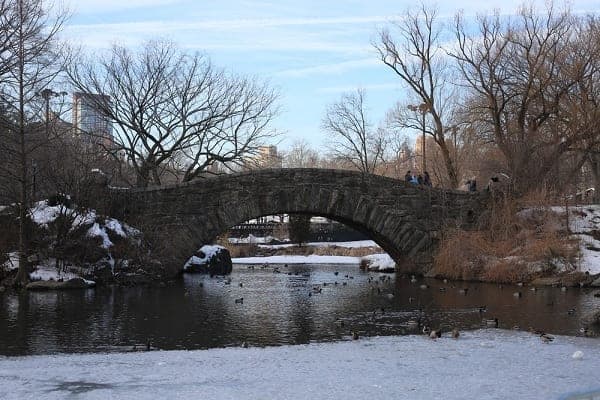
Gapstow Bridge arches over the Pond and offers one of the best views of Midtown from Central Park. It is a classic spot for a photo so have your camera ready.
It is also a popular location for marriage proposals to take place – so have a ring with you too!
Go north up the path and then head under the Inscope Arch towards the Central Park Zoo.
(C) Central Park Zoo
The Central Park Zoo happened by accident. It was not included in the original plans for the park but was started when New Yorkers started leaving “gifts” of exotic animals in the park.
The park found itself with a menagerie on its hands, including swans and bears. A couple of years later, the city decided to make it official.
The New York State Assembly recognized the Central Park Zoo, making it the second publicly owned zoo in the country.
The zoo has received two major overhauls. The first was in the 1930s when the zoo became the Robert Moses Zoo. During this renovation, the famous Sea Lion Pool was added.
This pool was considered groundbreaking because the designer actually studied the habits of sea lions and tried to make the pool resemble their natural habitat.
The next renovation occurred in the 1980s when the old-fashioned menagerie cages were taken out and replaced with natural, open habitats.
Many of the larger animals were moved to the Bronx Zoo. The Sea Lion Pool was redesigned and remains the central feature of the zoo.
Check out our full blog post on the Central Park Zoo.
On the way out, make sure you check out the Delacorte Clock.
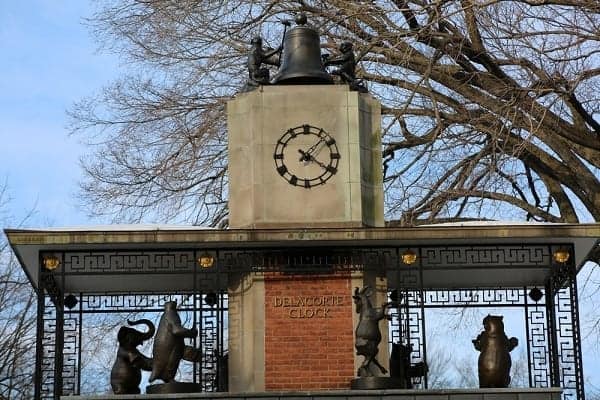
The clock was donated by George Delacorte and features animals that move in a circle to nursery rhymes every half-hour. (The clock plays 44 different songs!)
From the Zoo, walk north East Drive until you reach the 65th Transverse and turn left (west) and walk a bit down til you find the next stop.
(D) The Dairy
This Victorian-style cottage was a functioning dairy when the park opened. This part of the park is known as The Children’s District.
One of the major criticisms of the Greensward Plan, when it was released, was that it didn’t contain enough features for children. The Dairy and other children’s attractions were then added.
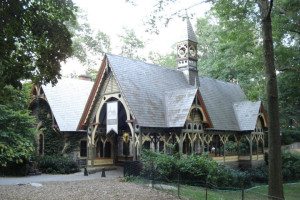
The Dairy was a place where children and their caretakers could go for refreshment and a break from the outdoors.
The dairy, designed by Calvert Vaux, served fresh milk and ice cream in the nineteenth century.
By the 1950s the building was dilapidated and was used as a maintenance shed.
When the Central Park Conservancy took over in 1979 the dairy was restored to its former appearance and became the first Visitor’s Center in the park.
Walk a bit further on the 65th Transverse to find the next stop.
(E) Chess and Checker House
The Chess and Checker House is also considered a part of The Children’s District.
When the park was built, this was the site of the Kinderberg (children’s mountain). The Kinderberg was the largest shelter for children and their parents.
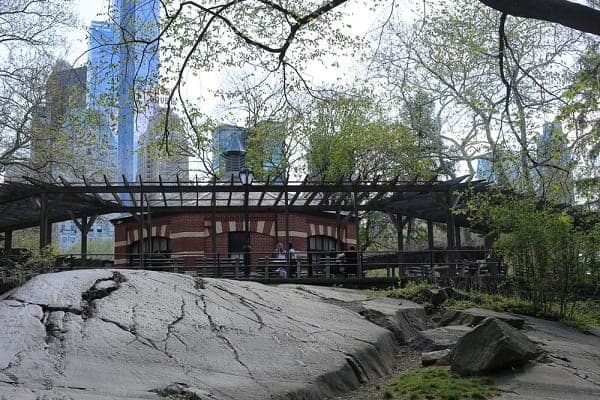
In 1952 the Chess and Checkers House was built to replace the Kinderberg. It was refurbished by The Central Park Conservancy in the 1980s when the shaded area was added.
Today, visitors are welcome to bring their own chess and checker sets or to borrow them from the Conservancy staff. Dominoes and backgammon are also available.
Look down the hill and check out the Wollman Rink, one of two rinks in Central Park.
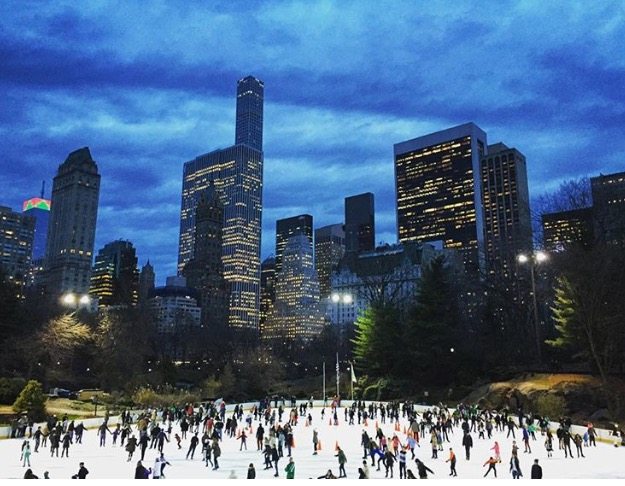
The rink is seen in a number of films, including the final scene of “Serendipity.” Check out our post on ice skating in NYC!
Now head down the path and through the red and white brick archway to the Carousel.
(F) The Carousel
The beautiful Carousel is one of the most beloved attractions in the park. It is the 4th carousel to stand in the park.
The first one, opened in 1873, was powered by a horse or mule under the platform. It was trained to stop walking in a circle when the operator tapped his foot on the platform.

This original carousel was replaced in 1924 and promptly burned down. The next one also burned down in 1950.
The current carousel was discovered abandoned in a trolley terminal in Coney Island.
It was constructed in 1908 and is considered one of the finest examples of American folk art in the country.
It has 57 horses and plays beautiful calliope music. The carousel runs 7 days a week in the summer.
For carousel lovers, you should visit Jane’s Carousel in DUMBO. It is one of a kind with the best views of the New York Skyline just behind it.
Head north up the path to the Sheep Meadow.
(G) Sheep Meadow
This massive grassy meadow got its name from the sheep that once grazed here.
The famous Tavern on the Green restaurant at the edge of the meadow was constructed as the Sheepfold in 1870.
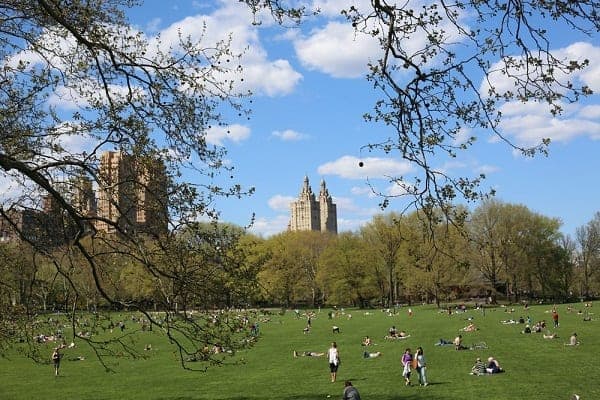
The area was used for grazing sheep until 1934 when they were removed to Prospect Park out of fear that New Yorkers impoverished by the Great Depression would eat the sheep.
The area was turned into a lawn and the Sheepfold became a restaurant.
On weekends, this is one of the most popular locations for New Yorkers to come and relax in the sun. It can be so crowded you may not find a spot to sit!
But it is an amazing experience to see so many locals basking in the sun and taking in the best the city has to offer.
Head east along main paths and you will find yourself at The Mall.
(H) The Mall
The Mall is the only path laid out as a straight line in the park. The designers did that so that there could be a big buildup leading to Bethesda Terrace, north of the Mall.

The American Elm trees that line both sides of the Mall, one of the largest collections of these trees in the United States. The trees create a “cathedral ceiling” over the pathway.
The Mall quickly became a popular spot for wealthy New Yorkers when the park opened. It was New York’s answer to Hyde Park or the Bois de Boulogne.
Carriages would drop people off at the start of The Mall and then loop around to the top to pick them up.
Also along the pathway is the Literary Walk, a collection of statues of famous writers. William Shakespeare is the first statue of the walk.

Many famous photographs and film scenes have been filmed here such as Doctor Who, Jessica Jones, Person of Interest, and the movie Enchanted.
You can head up north along the Mall or, for dog-lovers, you can take a quick detour and walk east (crossing over East Drive) to see Balto.
(I) Statue of Balto
Head out of the zoo and then cut over towards the center of the park. Look for the statue of a dogalong the path!
This statue is donated to all of the sled dogs that participated in the Great Race of Mercy, a dogsled run that relayed diphtheria antitoxin to the town of Nome, Alaska in 1925, effectively saving the town.
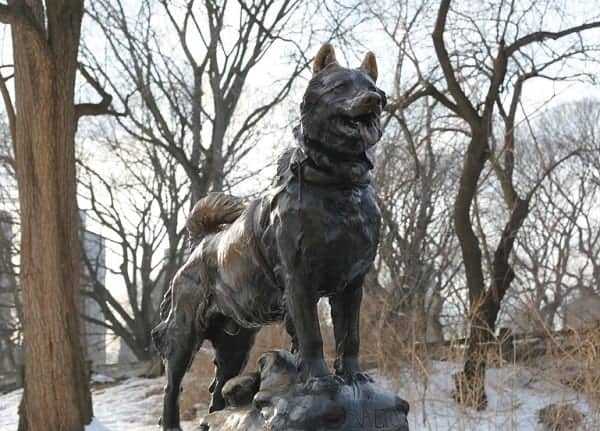
Balto, the dog featured in the statue, was the lead dog of the final team. He was present for his statue’s dedication later that year.
The statue’s shiny appearance comes from all of the children in the park “petting” him!
From Balto, double back to The Mall and head north. You will reach a set of stairs. Go down the stairs to check out the Minton tile ceiling in the Arcade.
(J) Bethesda Arcade
The underground Arcade was designed to be a contrast to the openness of Bethesda Terrace that it leads to.
Look up and see the spectacular ceiling, with 15,000 tiles made by the famous Minton Tile Company of England. The Bethesda Arcade is the only place in the world where these tiles are used for a ceiling.
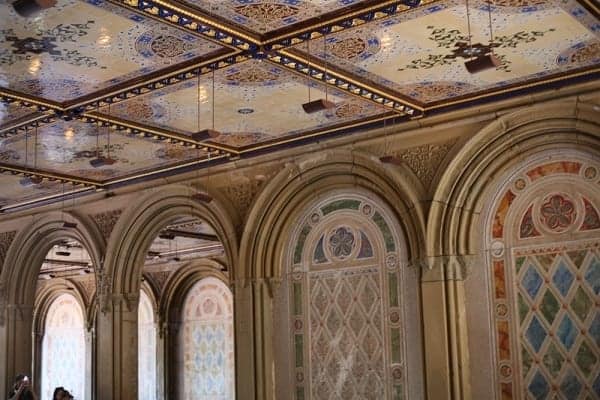
The ceiling was designed by Jacob Wrey Mould, who also designed many of the decorative carvings seen on Bethesda Terrace.
It was completed in 1869 and the ceiling weighs around 50 tons, and over the years the tiles deteriorated.
In the 1980s they were removed and placed in storage. After many years and many donations, the ceiling was finally restored in 2000.
The acoustics in the Arcade is wonderful, so take a minute to enjoy whatever musician is performing there when you visit.
Above the Arcade is a terrace with great views. Surrounding the arcade is a large palazzo style area made of reddish stone. This is one of the most famous locations in Central Park right in front of you.
(K) Bethesda Terrace and Fountain
The formal terrace was considered the heart of the park by the designers.
The central feature is the famous Bethesda Fountain with its Angel of the Waters statue. This statue is the only statue in the park that was specifically commissioned for the park.
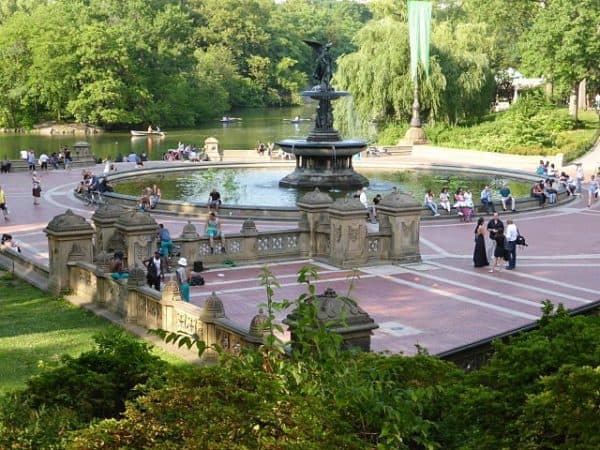
The terrace and fountain get their names from the Gospel of John, where a pool called Bethesda with healing waters is referenced.
This was all dedicated in honor of the Croton Aqueduct System, the water supply system that gives New York its drinking water today.
The creation of the aqueduct was a huge leap forward in New York’s development and it greatly reduced disease in the city and also helped decrease the number of fires in New York.
In the statue, the angel has her hand out, blessing the water for New York. The lily on her other hand represents the purity of the water.
This area is seen in dozens of films and TV shows, including Law and Order, Sex and the City, Enchanted, and Elf.
Fans of the Avengers will recognize the Terrace as the scene where they all depart from one another.
For superhero lovers, check out our self-guided tour of superhero locations in New York City.
Just beyond the fountain, you cannot miss the very big and bucolic lake.
(L) The Lake
The Lake was used year-round in the early days of the park. Visitors to the park rowed boats on the water in the summer and ice skating in the winter.
The Lake was used for ice skating all the way up until the 1950s when Wollman Rink was opened.
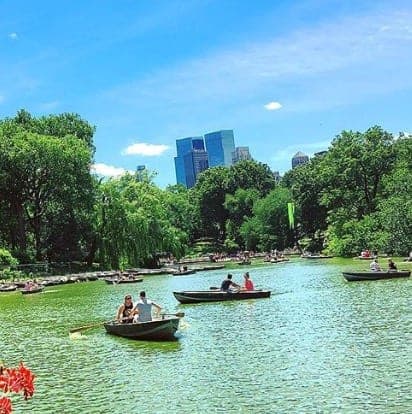
People can still enjoy rowing boats on the Lake today. It is pretty easy to get a rowboat and onto the lake. Kids especially enjoy this and it is an easy lake to navigate.
Head over to the Loeb Boathouse on the east side of the lake – you cannot miss it (They also serve food. See our FOOD section below).
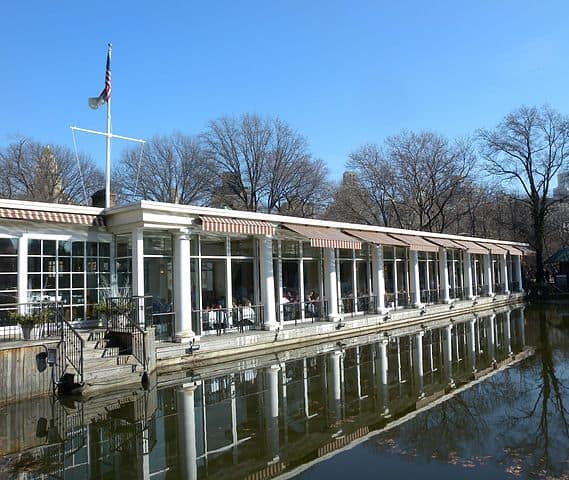
In good weather, rowboats are available for rent from 10 am till sundown. Boats are $15 per hour (cash only), $4.00 for each additional 15 minutes with a $20 cash deposit.
Each boat holds up to 4 people. The Loeb Boathouse will provide life jackets. Children under 12 must be accompanied by an adult.
Follow the path along the Lake until you come to the Loeb Boathouse. From there head east, cross East Drive and you will see a larger than life statue of a man and behind it a calm pool of water.
(M) The Conservatory Water
Fans of the book Stuart Little write will recognize this pond, which is usually filled with toy sailboats. This is where Stuart races a sailboat to victory in the book.

On the near side of the pond is a statue of the master of all fairy tales, Hans Christian Anderson.
He is seated on a slab of stone feeding “The Ugly Duckling” one of his most famous characters.
Absolutely pose for a picture with Hans – he is known for being quite friendly!
Walk north on the small path until you reach another playful statue.
(N) Alice in Wonderland
Alice in Wonderland is on the north end of the pond. It shows Alice and the Mad Hatter Tea Party.
The statue was donated by George Delacorte in honor of his wife Margarita Delacorte.

The design of the statue is taken from the illustration in the first edition of the novel that was ever released.
Feel free to climb on the sculpture and have fun in this whimsical part of the park.
Head northwest away from Alice and back towards the Loeb Boathouse Restaurant. Go to the back end of the Loeb Boathouse Restaurant to enter The Ramble.
(O) The Ramble
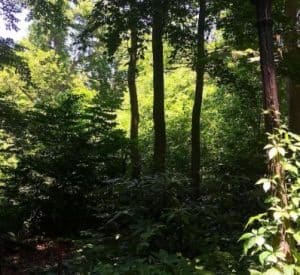
The Ramble was designed alongside Bethesda Terrace and The Lake as one of the key elements of the park.
The Ramble, which can be seen from Bethesda Terrace, is meant to be a juxtaposition to the formality of the terrace. The Ramble was built to resemble a wild forest and a place where you can truly escape the city.
Amazingly, despite its appearance, The Ramble is entirely manmade. Some of the trees in The Ramble today were original plantings in 1859.
The Ramble is known as being one of the best spots for bird-watching in the United States.
Over 230 different species have been spotted. Click here for much more information about the Ramble.
At this point, you may want to decide if you want to start to wrap up your tour by backtracking south to see Strawberry Fields and then leave the park or if you have the energy to keep going north for another 1 1/4 miles to see several more sites.
From the Ramble, head west, back towards the lake. When you reach the lake, you will get to a small cast-iron bridge.
(P) Bow Bridge
Completed in 1862. It is one of the most photographed and filmed locations in Central Park. Woody Allen’s film Manhattan, Spider-Man 3, and Night at the Museum have scenes filmed here.
Many marriage proposals take place here as well. It is definitely a special spot in the ark and if you cand time to get this into your route, you should.
Bow Bridge – Strawberry Fields – Dakota Building

Cross the bridge and veer to the right along the path. Follow the path along the lake for about 1/4 of a mile until you end up in Strawberry Fields. You will likely see signs guiding you to this very sacred spot.
(Q) Strawberry Fields and the Dakota Building
This quiet area of the park is dedicated to John Lennon, who lived just outside of the park in the Dakota Building.
The name comes from the Beatles song “Strawberry Fields Forever.” The garden was planned by the city and John Lennon’s widow Yoko Ono.
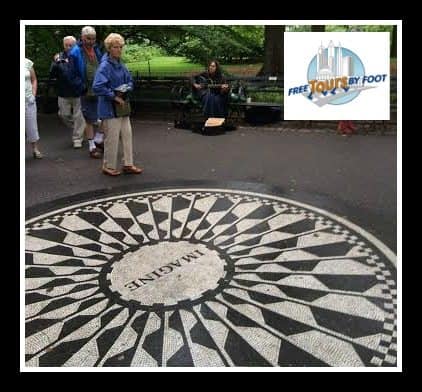
Its central feature is the Imagine Circle, donated by the city of Naples, Italy. It was designed by Italian mosaic artists and displays the name of Lennon’s most famous solo work.
Strawberry Fields is recognized as a “Garden of Peace” by 121 different countries and is one of the most popular parts of Central Park.
Check out our post for more information on Strawberry Fields.
Across the street from the exit from the park, you will see a very impressive unusual looking building. This is the renowned Dakota Building
Completed in 1884, the Dakota was New York’s first luxury apartment building.

It was financed by Edward Singer (of the Singer Sewing Machine Company), who decided that he could convince New Yorkers that apartments could be a viable option for the wealthy.
The Dakota offered many amenities, such as porters, maids, room service, a formal dining room, and electricity provided by an in-house generator.
There were 65 apartments, ranging in size from 4 rooms to 20.
Throughout its history, The Dakota has been famous as the home of many celebrities, including John Lennon and Yoko Ono. (Yoko Ono still lives in the building).
Check out our blog post on the Dakota for more information!
This is the last stop of the Southern Route. The nearest subway is right on that corner at 72nd Street and Central Park West. There you can catch the B or C trains uptown or downtown.
NORTHERN ROUTE
Leave the Ramble and walk north weaving along the paths.
Again, a map always comes in handy, but this is a fairly easy part of the park to navigate. You will get to the 79th Street Transverse. Cross over to the next stop.
(R) Belvedere Castle
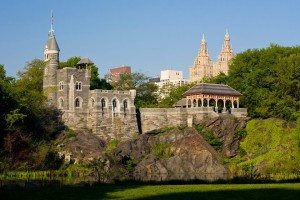
This castle, whose name means “beautiful view” in Italian, was designed by Calvert Vaux.
It is a “folly,” an architectural term for a purely decorative building, and was completed in 1869.
It was meant to be a lookout over the Croton reservoir to the north and The Ramble to the south, and it is one of the highest points in the park.
For years it was also used by the National Weather Service, who took weather readings for the city up in the castle’s tower. They still use the wind instruments up on top of the turret.
The castle was renovated in 1983 and became a Nature Center, where visitors can get information about the flora and fauna of the park and rent bird-watching kits.
Read our blog post on Belvedere Castle.
From Belvedere Castle, you will have a good view of Delacorte Theater, home of Shakespeare in the Park.
Go down the stairs on the west side of the castle. Turn left and go to the Shakespeare Garden.

Central Park’s Belvidere Castle and more | NYC virtual walk
One of the hidden treasures in Central Park is a beautiful fairytale-looking castle. Have a look! #centralParktours #visitnewyork #nyctoursPosted by Free Tours By Foot on Wednesday, October 27, 2021
(S)Shakespeare Garden
This beautiful garden was originally a flower garden called “Heart Garden.” It was redesigned and designated Shakespeare Garden in 1915, in honor of the famous poet and playwright William Shakespeare.
All of the plants and flowers in the garden are mentioned in the works of Shakespeare, and there are small plaques with quotations scattered throughout.
The designer also released 60 starlings (mentioned frequently in Shakespeare) into Central Park when the garden opened.
These birds were not native to North America, and those originals became over 150 million on this continent. Be sure to read our post on the famous summer event Shakespeare in the Park.
Walk through the garden and exit by the Swedish Cottage.
(T)The Swedish Cottage
This cottage was built in Sweden in 1875 and was brought to the United States as a part of the 1876 World’s fair.
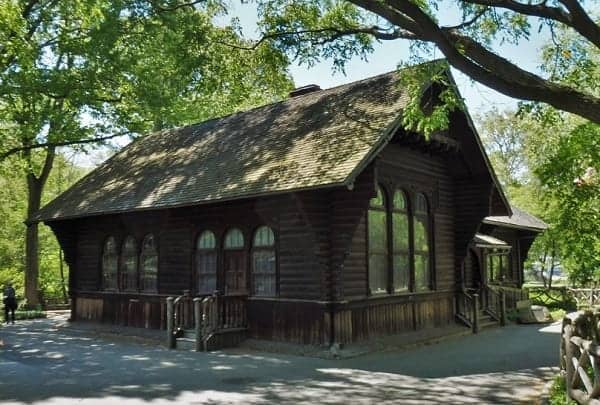
It was displayed in the Swedish Pavilion as an example of a traditional Swedish schoolhouse, where Fredrick Law Olmstead spotted it and decided that it would be a great addition to Central Park.
It was brought to New York in 1877.
Today it is the home of a marionette theater company known for its productions of fairy tales such as Cinderella and Peter Pan. It is the oldest continuously operating marionette theatre in the country.
From the cottage walk northwest 300 feet to the next stop.
(U) The Delacorte Theatre
This 1800 seat, open-air theatre is home to the famous Shakespeare in the Park performances every summer (read below for information on attending a performance).
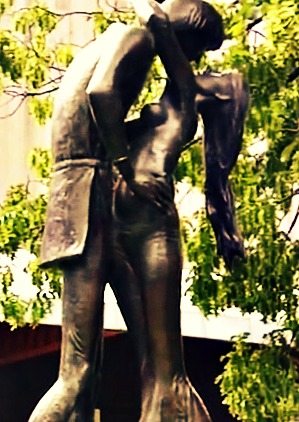
Built in 1962, the theatre was named for George T. Delacorte, Jr., who financed it. Over 100,000 people flock to this theatre every summer for its legendary free theatre performances.
TIP: There are public restrooms at this location!
Just 200 feet north of the Delacorte Theatre you will find the next stop. There is no missing it!
(V)The Great Lawn
This massive lawn is one of the most famous in the United States.
It was not a part of the original park design because it was the site of a massive reservoir that was part of the Croton Aqueduct System.
The reservoir was drained in 1931 and filled in with excavation from the building of Rockefeller Center and the 8th Avenue Subway.
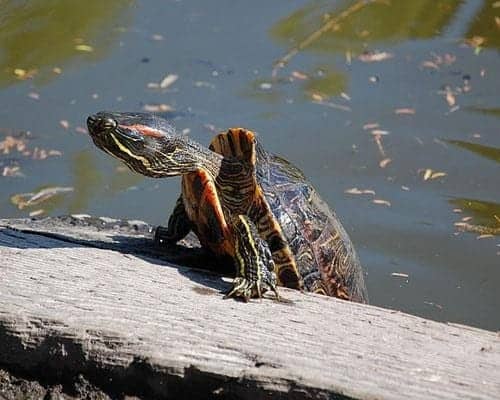
Over the years, the Great Lawn has been used for many concerts, including Simon and Garfunkel, Bon Jovi, and the New York Philharmonic, just to name a few.
Turtle Pond, the body of water at the south end of the lawn, is actually the last remaining part of the Croton Reservoir. It is named Turtle Pond for its many turtle inhabitants, as many as 5 different species!
From the Great Lawn look east and you will see a large obelisk. Walk towards it.
(W) Cleopatra’s Needle

The oldest object in the park. The obelisk was constructed in Egypt in 1400 BC.
The name is misleading because the obelisk was 1000 years old by the time Cleopatra began her legendary reign.
The obelisk in Central Park is a twin with a second Cleopatra’s Needle that can be found on the Thames River in London.
There is also one in Paris, but it is not a matched set with the other two.
The obelisk was moved from Alexandria to New York in 1880, and it was an arduous task.
A hole was cut into the hull of the ship, and the obelisk was rolled into it atop cannonballs.
Once it reached New York, it was moved in a wagon hitched up to 32 horses. They had to move very slowly so as not to jostle it too much. It took 112 days to move the obelisk from New York Harbor to Central Park.
Just past Cleopatra’s Needle is the next stop – actually the back end of it.
(X)The Metropolitan Museum of Art
This is probably the most well-known museum in the city. It was designed by Calvert Vaux and Jacob Wrey Mould and was opened in 1874.
The permanent collection has over 2 million items housed in about 2,000,000 square feet (19,000 square meters).
There are numerous collections, including a vast Egyptian collection, Impressionist Paintings, a massive armor collection, and the famous Metropolitan Costume Institute.
Continue north from the museum approximately 300 yards to the next stop.
(Y)The Jacqueline Kennedy Onassis Reservoir
The Reservoir is one of the most popular spots in the park.
The one billion gallons (3.7 billion liters) reservoir was built in the 1860s as a backup water supply for the city while the Croton Reservoir System was shut down for two weeks for repairs.
The Reservoir was permanently decommissioned in 1993. It was no longer needed because of a new underground water tunnel.
There is a dirt jogging track that goes around the water (approximately 1.6 miles or 2 km).
It was a favorite spot of Jackie Onassis’s to run while she lived in New York, so the Reservoir was renamed in her honor in 1994.
Walk along the east side of the Reservoir. It is approximately a 3/4 mile walk until you reach the 97th Street Transverse where the last stop is located.
(Z) The North Meadow
This 23 acres (10 hectares) meadow has 7 baseball fields and 5 softball fields. It is the largest meadow in Central Park.
The competition winners, Frederick Law Olmstead and Calvert Vaux were asked to include three areas for playing ball in their design because the sport was rapidly gaining popularity in the 19th century when the park was being built.
Today, the North Meadow is used by baseball teams in the spring and then is turned into football and soccer fields in the fall.
The North Meadow also has the North Recreation Center, which is a great place to find water fountains and restrooms while you are in the park.
This is the last stop on the Northern section of the park.
From here there a number of things you can do. We have listed activities further down in this post. Click here to jump down to that section.
If you want to either leave the area or stay and explore more outside of the park, here are some ideas:
- To subway Exit park at 97th Street. Walk down one block to 96th Street and walk east 3 blocks to Lexington Avenue for the entrance to the 6 train Uptown or Downtown. There is also a station at Lexington Avenue and 103rd street for 6 ttrains
- Visit Harlem using our neighborhood guide
- Nearby museums include:
- Jewish Museum 5th avenue and 92nd street
- Cooper-Hewitt Design Museum 5th avenue and 91st street
- Guggenheim Museum 5th avenue and 88th street
- Museum of the City of New York 5th avenue and 103rd street
- El Museo del Barrio 5th avenue and 104th street
MONEY-SAVING TIP: See our comprehensive guide to free museums, free entry days, and hours to certain museums.
MAPS OF CENTRAL PARK
The sheer size of Central Park makes it a great place to go to engage in all sorts of outdoor activities.
As big as the park is, however, you will definitely need a map of some sort to find your way through. Many a New Yorker has gotten lost in the park…more than once!

General Maps
These are some of the better basic maps of the park that give you a broad overview of the main attractions, large paths, locations of restrooms, and food.
Some are interactive, printable, or in PDF form for you to download.
- These are two printable maps on the same website: the first is a map of top attractions surrounding the park as well as a few inside. This is useful so you know about other places you may want to visit when you are finished with the park. The second map is a very clear-cut map of the park and about 30 key locations to visit.
- This excellent, free printable and downloadable map is from the Central Park Conservancy and has all the essentials you need – points of interest, visitor centers and facilities, paths and major roads and also all the nearby subways.
- This interactive map is also from the Central Park Conservancy. It is a comprehensive map that will help you find playgrounds, places to eat, and cultural points of interest. You can use the map legend to select what types of things you want to see on the map. It also has a feature where you can click an icon and get a summary and more information.
Playground Maps
- The Plan for Play interactive map is simply the best map ever to find out easily where all the playgrounds are in the park (and there are many!). It is easy on the eyes, but don’t let its visual simplicity fool you. This map has links you can click on to find out the history of the parks, photos of the park and any other pertinent information.
- This link is to the official NYC Parks department list of playgrounds with addresses. While it is not a visual map, it is essential for planning in advance if you are traveling with someone who needs accessibility due to a wheelchair or other reason. Also, this list states which parks have adaptable swings for children with special needs.
Biking Maps
- This biking map is a JPEG that you could save on your smart device. It is user-friendly and includes a legend so you know where the bike lanes get hilly and where you can find water – which you will probably need!
- This interactive map is great for its use of a detailed legend letting you know such things as which bike paths has restricted hours, shared with vehicles and more. It also has a chart of elevations at various parts of the park.
Jogging and Running
See our detailed post with interactive maps and tips
Free or Limited Free Wifi Spots
- The official Parks Department map of wifi spots in the park.
- See our post on free wifi throughout New York City.
Bathrooms Although this PDF map is meant for runners, well, everyone has to go sometime! The map has all the bathrooms in the park marked on it. There are about 20 bathrooms in the park, and not all are the cleanest, you may want to bring some tissues or napkins with you!
ACTIVITIES IN CENTRAL PARK
RIDE A BIKE!
If you are unable to join us for a Central Park Bike Tour, you can still enjoy cruising around the park!
There are many rental options available for visitors.
Central Park Sightseeing Bike Rentals 56 W 56th Street
Our guests are entitled to 20% off on all of our partner shop’s Central Park bike tours. Just use promo code FTBF.
Rates: start at $15/hr (but cheaper per hour if you do a longer rental) Rate includes a helmet, lock, and a bike basket.
CitiBike Location: docking stations on the south end of the park-west, middle and east.
Price: $9.95 for a 24-hour access pass. (CitiBike is intended for shorter trips, so the unlimited use is only for 30-minute trips. The charge for the second half-hour is $4)
GO FOR A RUN!
Central Park is one of the best spots for running in the city. It offers different distance options and terrains. For detailed information on running and jogging in the park, check out our post on running in the park.
TAKE A HORSE AND CARRIAGE RIDE!
Our post on horse and carriage ride companies compares the different options and the costs.
ROLLERSKATE!
Every year, from mid-April to late October, on most Saturdays and Sundays, the Central Park Dance Skaters Association offers a roller skate-dance party in the “Skate Circle”.
It’s located mid-park area, south of the 72nd Street Traverse. Check their website on how to find the Skate Circle.
The event runs from 2:45-6:45 and music is provided by a DJ. Check their event calendar to see what’s on.
It is free to attend, but bring your own skates! These events are done weather-permitting and provided there is not another major event in the park.
TAKE IN A FREE CONCERT OR PLAY!
New York Philharmonic Concert in the Park
Every summer, usually in mid-June, the New York Philharmonic puts on a free performance in Central Park’s Great Lawn.
This is one of the most awaited events of the summer and tens of thousands of New Yorkers show up with blankets and picnic baskets.
If you can make it, this is a quintessential New York experience.
Shakespeare in the Park
Each summer, the Public Theater hosts this free festival in which two Shakespeare plays are performed for the public at the Delacorte Theater.
Although it is not easy to get tickets, you can be sure to read our post 5 Ways to Get Free Tickets to Shakespeare in the Park.
Summer Stage
Summer Stage is a summer concert series held in central park.
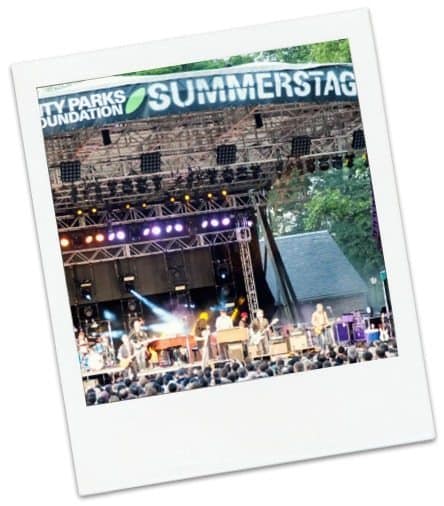
It began in the Naumberg Bandshell in 1968 and grew into its new venue, just south of the 72nd Street Traverse in the middle of the park.
There are dozens of concert events throughout the summer.
Check our Summerstage post for the annual line-ups and dates.
Free Musical Performances
Several spots and venues in the park have free music, either as part of a scheduled series, such as the Naumburg Bandshell which puts on music events, such as the Naumburg Orchestral Concert series in the summer.
There are other musicians and performers throughout the park and in good weather, you will likely come across some.
FOOD AND NEARBY HOTELS
FOOD
Tavern on the Green – 67th Street at Central Park West
This restaurant, once the sheepfold, has become a New York City landmark. It reopened in 2014 with new owners after a massive renovation.
Price: $$$; Cuisine: American; Credit Cards Accepted: Yes; Attire: Dressy
The Loeb Boathouse – 75th Street on East Side of Park
Set on the edge of The Lake, this restaurant has an unbeatable ambiance.
The outdoor dining terrace is seen in many films and TV shows, including When Harry Met Sally and Sex and the City.
For fans of Sex and the City, check out our posts about how to find Carrie’s apartment, our free, self-guided Sex and the City Tour Sights, and where to get those luscious cupcakes at Magnolia Bakery NYC.
Note: Only openduring the months of April-November. The Boathouse only offers dinner only.
Price: $$$; Cuisine: American; Credit Cards Accepted: Yes; Attire: Casual.
Boathouse Express Café 75th Street on East Side of Park
Tucked behind the more well-known lakefront restaurant, this take-out café offers quick fare for a reasonable price. Price: $; Cuisine: American; Credit Cards Accepted: Yes; Attire: Casual
Le Pain Quotidien West 69 Street Inside Park. Enter the park at West 69th Street path.
This casual restaurant offers both sit-down and take-out service.
It is located in the historic Mineral Springs pavilion, on the north end of the Sheep Meadow. In the late 19th and early 20th centuries, park-goers could go to this pavilion for a drink of fresh spring water.
Price: $$, Cuisine: Organic café/boulangerie; Credit Cards Accepted: Yes; Attire: Casual.
Tucked behind the more well-known lakefront restaurant, this take-out café offers quick fare for a reasonable price.
Price: $; Cuisine: American; Credit Cards Accepted: Yes; Attire: Casual
Snack Carts Grabbing a hot dog or pretzel off of a cart is something many visitors want to experience while in NYC.
You can find these carts all throughout the park. Varied, all throughout the park.
Price: $. Cuisine: Hot dogs, pretzels, churros, and ice cream. Credit Cards Accepted: No. Attire: Whatever you’re wearing!
HOTELS NEARBY THE PARK
If being right by Central Park is a must for your stay, you might want to consider the Upper West or Upper East Side.
Take a look at our post 25 Cheap (And Nice!) Hotels In New York City which includes some excellent hotels right near the park.
Upper West Side
- Quick access to The American Museum of Natural History, New York Historical Society and Lincoln Center.
- Many budget-friendly accommodation options, including hostels, inexpensive hotels and Air B&B rentals.
- You have multiple subway options. The 1,2 and 3 trains run on Broadway and the B and C trains run on Central Park West. These lines can take you to a number of destinations all over the city.
- Wide variety of restaurants and bars, including some lively nightlife along Amsterdam Avenue.
Upper East Side
- Quick access to Museum Mile, including the Metropolitan Museum of Art and the Guggenheim.
- Nice walk or a quick subway ride to 5th Avenue shopping.
- The 4, 5 and 6 trains run along Lexington Avenue on the Upper East Side. Though these trains can get a little crowded during rush hour, they are great for getting to a lot of NYC hotspots.
- Good nightlife along 1st and 2nd Avenue with a wide variety of restaurants and bars!
HISTORY OF CENTRAL PARK
Central Park was designed as an urban oasis to give New Yorkers an escape from the crowded city. The original design for New York, aid out by the City Commissioners in 1811 did not include a park.
Between that time and the 1850s, the city of New York quadrupled in size. As the city got more and more crowded, New Yorkers started seeking a respite.
Landscaped cemeteries became a popular place to stroll and picnic because they were among the only public green spaces in the city. It was time for a change in New York.
In 1853 the city purchased the land that would become Central Park for $5 million.
To ensure that they were getting the best design possible, they held a design competition to determine what the future park would look like.
The design team of Frederick Law Olmstead and Calvert Vaux won the completion with a design called “The Greensward Plan.”
Even though the Greensward Plan was meant to look very naturalistic, this 843-acre park is entirely man-made.
The plan entailed clearing land as long as 2.5 miles (4 km) from 59th Street to 110th Street and is 0.5 miles or (0.8 km) wide between 5th Avenue and Central Park West.
The layout plan encompassed the use of 843 acres (341 hectares) right in the middle of Manhattan.
The park was a massive undertaking. Construction began in 1857 and was completed in 1873.
Over 1500 residents had to be cleared from the area, particularly in Seneca Village, home to the Seneca Native American tribe.
Even just preparing the land for landscaping was a feat. The Manhattan schist (the bedrock that makes up the island) had to blast apart in many areas using gunpowder.
There was more gunpowder used in building Central Park than was used in the Battle of Gettysburg in the American Civil War.
It was also determined that the soil in the area was not suitable for all of the planting that was planned. The topsoil was removed, and new soil was brought in from New Jersey.
All in all, during the park’s construction, more than 10 million cartloads of rubble were carted out.
The end result of the years and labor that went into the development of this park was a success so great that New Yorkers, then and now, regard Central Park as one of its most-loved treasures.
We hope it has now become one of your favorite places. Join our free FTBF Travel Community. As a thank you, you’ll receive a trip planner and FREE audio tour.
Which City? I want them all PLUS general travel tips. Amsterdam Berlin Boston Charleston Chicago Dubai Lisbon London Los Angeles Miami Nashville New York City New Orleans Paris Philadelphia Prague Rome San Francisco Washington DC
About The Author

Stephen Pickhardt
Stephen is the CEO of Free Tours by Foot and has overseen the transformation of a local walking tour company into a global tour community and traveler’s advice platform. He has personally led thousands of group tours in the US and Europe, and is an expert in trip planning and sightseeing, with a focus on budget travelers. Stephen has been published and featured in dozens of publications including The Wall Street Journal, BBC, Yahoo, Washington.org, and more.